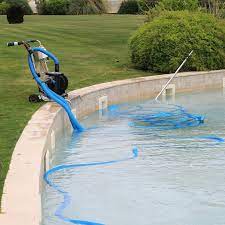
If your pool keeps growing algae even after shocking, brushing, and maintaining chlorine levels — the real culprit might be phosphates. These invisible nutrients feed algae growth, making it harder to maintain clear, clean water. Understanding and managing phosphates is especially important for Florida homeowners in areas like Port Charlotte, Punta Gorda, North Port, and Rotonda, where warm temperatures and rain accelerate algae growth.
What Are Phosphates and Why Do They Matter?
Phosphates are compounds containing phosphorus — a natural fertilizer for algae. Even trace amounts (as low as 100 ppb) can help algae multiply faster than your sanitizer can kill it.
Common Sources of Phosphates in Pools:
- Rainwater runoff carrying fertilizer or decaying leaves
- Soil and plant debris blowing into uncovered pools
- Tap water — especially in older municipal systems
- Swimmers’ products like sunscreen, shampoo, or detergents
- Bird droppings or organic debris
Florida Insight: With heavy rains and plant growth nearly year-round, phosphate buildup happens faster here than in cooler regions.
How Phosphates Affect Pool Health
Phosphates don’t directly harm swimmers — but they indirectly cause constant algae blooms, cloudy water, and increased chlorine demand.
If your pool seems to “eat up” chlorine too quickly, high phosphates could be the cause.
Signs of Excess Phosphates:
- Greenish tint despite good chlorine levels
- Recurrent algae on walls or steps
- Cloudy or dull water
- Difficulty maintaining sanitizer balance
Testing for Phosphates
Testing is simple and can be done at home or by a professional.
Options:
- Phosphate Test Strips – quick, affordable, and available at most pool stores.
- Liquid Test Kits – more precise and used by professionals.
- Professional Water Analysis – offered by local companies like Florida Detail, providing detailed phosphate and metal readings.
Ideal phosphate level: Below 100 parts per billion (ppb).
If readings exceed 500 ppb, take corrective action immediately.
How to Lower Phosphate Levels Effectively
1. Remove Debris Frequently
Skim and vacuum your pool at least twice weekly — especially after storms.
Fallen leaves, pollen, and dirt are major phosphate sources.
See PoolCleaningInPortCharlotte.com for local debris-removal and vacuuming tips specific to coastal Florida.
2. Backwash or Clean Filters Regularly
Your filter traps organic matter that breaks down into phosphates over time.
- Backwash sand filters monthly.
- Rinse cartridge filters every 4–6 weeks.
- For DE filters, clean grids and inspect for buildup every 3 months.
Pro Tip: Replace filter media every 3–5 years to prevent phosphate “memory” buildup.
3. Use a Phosphate Remover
Phosphate removers (like lanthanum-based products) bind with phosphates, making them insoluble so they can be filtered out.
How to apply:
- Balance your pool’s pH and chlorine first.
- Add the remover per label instructions.
- Run the pump continuously for 24–48 hours.
- Backwash or rinse filters afterward.
Warning: Overuse can cause temporary cloudiness — that’s normal as the remover binds with phosphates.
4. Control Source Water
Test your fill water for phosphates.
If the level is high, consider:
- Using a pre-filter on your hose.
- Treating with phosphate remover during refills.
5. Maintain Chlorine and Circulation
Even after phosphate reduction, you need solid sanitation:
- Keep chlorine between 2–4 ppm.
- Run the pump 8–10 hours daily during Florida’s hot months.
- Brush walls weekly to break up early algae films.
Learn how to keep chemical balance optimized through Florida Detail’s Pool Chemistry Guide.
6. Schedule Routine Professional Inspections
Many homeowners in Charlotte County combine DIY upkeep with quarterly professional service.
Technicians can:
- Test phosphate levels precisely.
- Apply professional-grade treatments.
- Identify hidden organic buildup sources.
For trusted providers, visit NorthPortPoolCompany.com or PortCharlottePoolService.com.
Prevention Is Better Than Cure
Keeping phosphates under control isn’t a one-time fix — it’s a habit.
Regular cleaning, controlled chemical balance, and mindful water management make a huge difference.
Quick Recap:
✅ Skim debris often
✅ Clean filters regularly
✅ Test phosphates monthly
✅ Apply removers when levels exceed 500 ppb
✅ Keep sanitizer balanced year-round
Florida’s warm, algae-friendly climate means phosphate prevention is essential — not optional.
Final Thoughts
Persistent algae blooms can frustrate even the most diligent pool owners, but once you control phosphates, the fight becomes much easier. With the right maintenance routine and occasional professional help, your water will stay sparkling and algae-free all year long.
Explore more pool care solutions and local services at Florida Detail — your trusted Charlotte County resource for pool health, maintenance, and safety.
